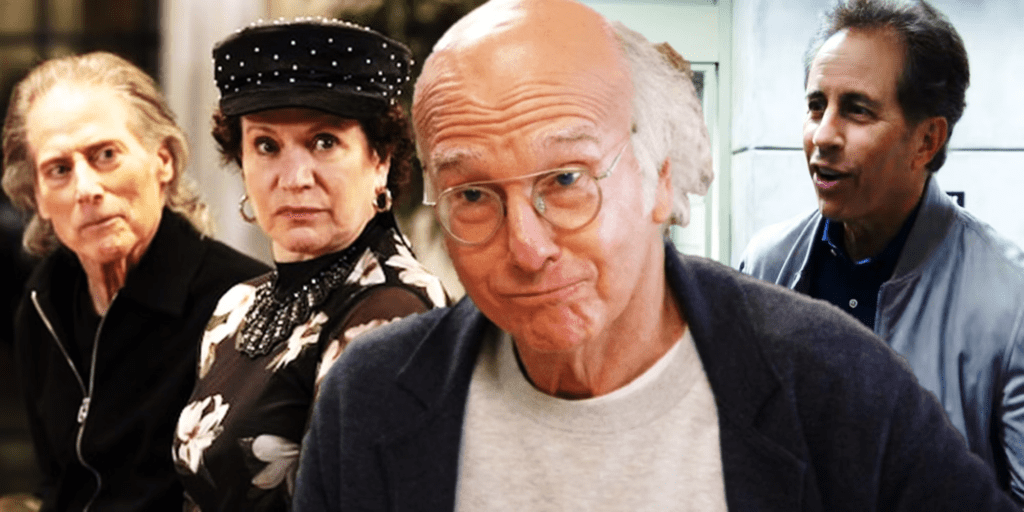Curb Your Enthusiasm Finale happened after 12 seasons on the air. For fans of Larry David’s long-running sitcom, it was a bittersweet but fitting ending.
The show “Curb Your Enthusiasm,” created by Larry David (also the co-creator of “Seinfeld”), features David playing a fictional version of himself. The series finale cleverly referenced the ending of “Seinfeld” with similar situations and even brought back some familiar characters from that show.
Curb Your Enthusiasm Finale
The series finale of “Curb Your Enthusiasm,” titled “No Lessons Learned,” brings Larry full circle in a hilarious way.

Larry gets arrested in Atlanta for something he did in the first episode of the season (violating the fictional Election Integrity Act of 2021). He ends up on trial, facing the consequences of his actions. During the trial, the prosecution brings in a surprise: a parade of characters Larry has wronged throughout the series!
Familiar faces like Mocha Joe (the coffee shop owner), Irma (Larry’s long-suffering manager), and even Bruce Springsteen himself appear as character witnesses, all testifying against Larry and highlighting his many quirks and bad deeds.
The series finale of “Curb Your Enthusiasm” offers a hilarious and unexpected conclusion that cleverly mirrors the ending of its predecessor, “Seinfeld.” In “No Lessons Learned,” Larry David, playing a fictionalized version of himself, faces trial for violating an election law. The twist? The prosecution calls upon a series of characters Larry has wronged throughout the show. Familiar faces like Mocha Joe and Irma take the stand, testifying against him and highlighting his many quirks and bad habits.
Also Read: Mary and George Episode 1 Recap Season 2. Discover Everything You Need To Know
This approach cleverly echoes the ending of “Seinfeld” titled “The Finale.” In that episode, Jerry, George, Elaine, and Kramer all end up on trial for their own bad behavior – failing to help a carjacking victim. Just like Larry, their past comes back to bite them as former acquaintances and people they’ve wronged become character witnesses, exposing their flaws for the court. By using a similar structure, “Curb Your Enthusiasm” not only delivers a satisfying conclusion that reflects the show’s core themes, but also pays homage to its earlier success story, “Seinfeld.”

The twist is how the “Curb Your Enthusiasm” ending differs. “Seinfeld” ends with the four leads being found guilty and sentenced to a year in prison; the last we see of them, they’re all actually serving out their sentences. A conversation they have in the jail cell is a callback to a conversation in the very first episode of the series.
The “Curb Your Enthusiasm” finale mirrors “Seinfeld’s” ending in some key ways. Larry, just like Jerry and the gang in “Seinfeld,” is found guilty and sentenced to a year in prison. He even references an earlier episode with a complaint about his “pants tent.”
Also Read: Quiet on Set Episode 5 Review: Breaking the Silence!
However, the shows diverge here. Larry escapes prison thanks to a technicality – a juror violated sequester, according to Jerry Seinfeld himself, who appears in the episode as a fictionalized version of himself. This unexpected twist frees Larry.
Things get even more interesting when Jerry tells Larry, “You don’t want to end up like this. Nobody wants to see it. Trust me.” This is a meta-reference to the criticism the “Seinfeld” finale received. Larry even agrees, saying “this is how we should’ve ended the finale.” Both characters seem to acknowledge that the “Curb” ending is superior.
The series concludes with Larry on a plane back home with his friends, leaving his fate – and the possibility of future awkward situations – open for interpretation.
The “Seinfeld” finale, which aired in 1998, remains a controversial topic even after 25 years. Despite attracting a massive audience of 76.3 million viewers, the ending left a sour taste in the mouths of some fans and critics alike.
Reviews were harsh. Entertainment Weekly’s Ken Tucker slammed the finale with a C- grade, accusing show co-creator Larry David (who returned for the finale after leaving the show earlier) of being a “spiteful, unforgiving moralist” for punishing the main characters for their years of bad behavior.
“From the episode’s start (an oddly paced coffee-shop scene) to an ending that was like a Samuel Beckett first draft, the show’s swan song was off-key and bloated,” Tucker wrote.
Even Seinfeld himself had some regrets about the divisive ending. “I sometimes think we really shouldn’t have even done it,” he said in an interview at the New Yorker Festival in 2017, per Vulture. “There was a lot of pressure on us at that time to do one big last show, but big is always bad in comedy.”

Ironically, even though some are now saying David “fixed” things with the twist in the “Curb” ending, the comedian has been a defender of the “Seinfeld” series finale all along. In season seven of “Curb,” where the main cast of “Seinfeld” appeared for an arc where they reunited to “make up for the finale,” the fictionalized Larry insisted it was “a good finale.”
David has also suggested that the bad reception to the “Seinfeld” finale even took the pressure off for him wrapping up “Curb,” in a way — which makes it even more clever how he brought that ending back for a re-do.

“I got so much grief from the ‘Seinfeld’ finale, which a lot of people intensely disliked, that I no longer feel a need to wrap things up,” David told Grantland in 2014, adding that he thought the conceit for bringing back all the characters in the finale trial was “clever.”
Clearly, that gimmick worked better this time around — “No Lessons Learned” is the highest-rated episode of “Curb” on IMDb as of writing.
The “Seinfeld” Finale Revisited
The original “Seinfeld” finale, co-written by David and Jerry Seinfeld, faced mixed reviews. While criticized at the time, it holds up better today. In a way, it already resembled a typical “Curb” episode more than a classic “Seinfeld” one.
The “Curb” finale echoed this formula, revisiting the trial scenario. However, it surprised me that the character witnesses were mostly from recent episodes, lacking the weight of iconic figures like the Soup Nazi. In the “Seinfeld” finale, the characters are confined to prison due to years of mistreating others. It felt like prime Larry David—constructing events that made sense, sort of.
Larry David’s ability to blend nostalgia, wit, and unpredictability leaves us pondering: Can two distinct worlds—“Seinfeld” and “Curb Your Enthusiasm”—truly coexist?










